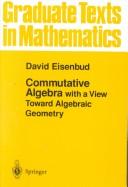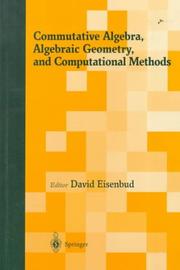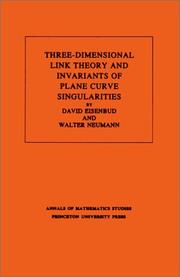| Listing 1 - 10 of 27 | << page >> |
Sort by
|
Book
ISBN: 0387264566 Year: 2005 Volume: 229 Publisher: New York, NY : Springer New York : Imprint: Springer,
Abstract | Keywords | Export | Availability | Bookmark
 Loading...
Loading...Choose an application
- Reference Manager
- EndNote
- RefWorks (Direct export to RefWorks)
Algebraic Geometry often seems very abstract, but in fact it is full of concrete examples and problems. This side of the subject can be approached through the equations of a variety, and the syzygies of these equations are a necessary part of the study. This book is the first textbook-level account of basic examples and techniques in this area. It illustrates the use of syzygies in many concrete geometric considerations, from interpolation to the study of canonical curves. The text has served as a basis for graduate courses by the author at Berkeley, Brandeis, and in Paris. It is also suitable for self-study by a reader who knows a little commutative algebra and algebraic geometry already. As an aid to the reader, an appendix provides a summary of commutative algebra, tying together examples and major results from a wide range of topics. David Eisenbud is the director of the Mathematical Sciences Research Institute, President of the American Mathematical Society (2003-2004), and Professor of Mathematics at University of California, Berkeley. His other books include Commutative Algebra with a View Toward Algebraic Geometry (1995), and The Geometry of Schemes, with J. Harris (1999).
Syzygies (Mathematics) --- Commutative algebra. --- Geometry, Algebraic. --- Algebraic geometry --- Geometry --- Algebra --- Syzygy theory (Mathematics) --- Categories (Mathematics) --- Rings (Algebra) --- Geometry, algebraic. --- Algebra. --- Algebraic Geometry. --- Mathematics --- Mathematical analysis --- Algebraic geometry.

ISBN: 0387942696 0387942688 9780387942698 9780387942681 3540942696 9783540942696 3540781226 1461253500 Year: 1995 Volume: 150 Publisher: New York, N.Y. Springer
Abstract | Keywords | Export | Availability | Bookmark
 Loading...
Loading...Choose an application
- Reference Manager
- EndNote
- RefWorks (Direct export to RefWorks)
Commutative Algebra is best understood with knowledge of the geometric ideas that have played a great role in its formation, in short, with a view towards algebraic geometry.The author presents a comprehensive view of commutative algebra, from basics, such as localization and primary decomposition, through dimension theory, differentials, homological methods, free resolutions and duality, emphasizing the origins of the ideas and their connections with other parts of mathematics. Many exercises illustrate and sharpen the theory and extended exercises give the reader an active part in complementing the material presented in the text.One novel feature is a chapter devoted to a quick but thorough treatment of Grobner basis theory and the constructive methods in commutative algebra and algebraic geometry that flow from it. Applications of the theory and even suggestions for computer algebra projects are included.This book will appeal to readers from beginners to advanced students of commutative algebra or algebraic geometry. To help beginners, the essential ideals from algebraic geometry are treated from scratch. Appendices on homological algebra, multilinear algebra and several other useful topics help to make the book relatively self- contained. Novel results and presentations are scattered throughout the text.
Algebraic geometry --- Ordered algebraic structures --- Geometry, Algebraic --- Commutative algebra. --- Geometry, Algebraic. --- 512.71 --- #KVIV:BB --- 512.71 Commutative rings and algebras. Local theory. Foundations of algebraic geometry --- Commutative rings and algebras. Local theory. Foundations of algebraic geometry --- Commutative algebra --- Geometry --- Algebra

ISBN: 0387222154 0387222324 0387264566 9780387222158 9780387222325 9780387264561 Year: 2005 Publisher: New York Springer
Abstract | Keywords | Export | Availability | Bookmark
 Loading...
Loading...Choose an application
- Reference Manager
- EndNote
- RefWorks (Direct export to RefWorks)
"Algebraic Geometry often seems very abstract, but in fact it is full of concrete examples and problems. This side of the subject can be approached through the equations of a variety, and the syzygies of these equations are a necessary part of the study. This book is the first textbook-level account of basic examples and techniques in this area. It illustrates the use of syzygies in many concrete geometric considerations, from interpolation to the study of canonical curves. The text has served as a basis for graduate courses by the author at Berkeley, Brandeis, and in Paris. It is also suitable for self-study by a reader who knows a little commutative algebra and algebraic geometry already. As an aid to the reader, the appendices provide summaries of local cohomology and commutative algebra, tying together examples and major results from a wide range of topics."--Publisher's website.
Commutative algebra. --- Geometry, Algebraic. --- Syzygies (Mathematics). --- Commutative algebra --- Geometry, Algebraic --- Syzygies (Mathematics) --- Syzygy theory (Mathematics) --- Categories (Mathematics) --- Rings (Algebra) --- Algebraic geometry --- Geometry --- Algebra

ISBN: 0867202858 9780867202854 Year: 1992 Publisher: Boston: Jones and Bartlett,
Abstract | Keywords | Export | Availability | Bookmark
 Loading...
Loading...Choose an application
- Reference Manager
- EndNote
- RefWorks (Direct export to RefWorks)

ISBN: 9814021504 Year: 1999 Publisher: Singapore : Springer,
Abstract | Keywords | Export | Availability | Bookmark
 Loading...
Loading...Choose an application
- Reference Manager
- EndNote
- RefWorks (Direct export to RefWorks)
Digital
ISBN: 9780387264561 Year: 2005 Publisher: New York, NY Springer Science+Business Media, Inc
Abstract | Keywords | Export | Availability | Bookmark
 Loading...
Loading...Choose an application
- Reference Manager
- EndNote
- RefWorks (Direct export to RefWorks)
Algebra --- Geometry --- algebra --- landmeetkunde

ISBN: 0691083819 0691083800 1400881927 9780691083810 9780691083803 Year: 1985 Volume: 110 Publisher: Princeton Princeton University Press
Abstract | Keywords | Export | Availability | Bookmark
 Loading...
Loading...Choose an application
- Reference Manager
- EndNote
- RefWorks (Direct export to RefWorks)
This book gives a new foundation for the theory of links in 3-space modeled on the modern developmentby Jaco, Shalen, Johannson, Thurston et al. of the theory of 3-manifolds. The basic construction is a method of obtaining any link by "splicing" links of the simplest kinds, namely those whose exteriors are Seifert fibered or hyperbolic. This approach to link theory is particularly attractive since most invariants of links are additive under splicing.Specially distinguished from this viewpoint is the class of links, none of whose splice components is hyperbolic. It includes all links constructed by cabling and connected sums, in particular all links of singularities of complex plane curves. One of the main contributions of this monograph is the calculation of invariants of these classes of links, such as the Alexander polynomials, monodromy, and Seifert forms.
Algebraic geometry --- Differential geometry. Global analysis --- Link theory. --- Curves, Plane. --- SINGULARITIES (Mathematics) --- Curves, Plane --- Invariants --- Link theory --- Singularities (Mathematics) --- Geometry, Algebraic --- Low-dimensional topology --- Piecewise linear topology --- Higher plane curves --- Plane curves --- Invariants. --- 3-sphere. --- Alexander Grothendieck. --- Alexander polynomial. --- Algebraic curve. --- Algebraic equation. --- Algebraic geometry. --- Algebraic surface. --- Algorithm. --- Ambient space. --- Analytic function. --- Approximation. --- Big O notation. --- Call graph. --- Cartesian coordinate system. --- Characteristic polynomial. --- Closed-form expression. --- Cohomology. --- Computation. --- Conjecture. --- Connected sum. --- Contradiction. --- Coprime integers. --- Corollary. --- Curve. --- Cyclic group. --- Determinant. --- Diagram (category theory). --- Diffeomorphism. --- Dimension. --- Disjoint union. --- Eigenvalues and eigenvectors. --- Equation. --- Equivalence class. --- Euler number. --- Existential quantification. --- Exterior (topology). --- Fiber bundle. --- Fibration. --- Foliation. --- Fundamental group. --- Geometry. --- Graph (discrete mathematics). --- Ground field. --- Homeomorphism. --- Homology sphere. --- Identity matrix. --- Integer matrix. --- Intersection form (4-manifold). --- Isolated point. --- Isolated singularity. --- Jordan normal form. --- Knot theory. --- Mathematical induction. --- Monodromy matrix. --- Monodromy. --- N-sphere. --- Natural transformation. --- Newton polygon. --- Newton's method. --- Normal (geometry). --- Notation. --- Pairwise. --- Parametrization. --- Plane curve. --- Polynomial. --- Power series. --- Projective plane. --- Puiseux series. --- Quantity. --- Rational function. --- Resolution of singularities. --- Riemann sphere. --- Riemann surface. --- Root of unity. --- Scientific notation. --- Seifert surface. --- Set (mathematics). --- Sign (mathematics). --- Solid torus. --- Special case. --- Stereographic projection. --- Submanifold. --- Summation. --- Theorem. --- Three-dimensional space (mathematics). --- Topology. --- Torus knot. --- Torus. --- Tubular neighborhood. --- Unit circle. --- Unit vector. --- Unknot. --- Variable (mathematics).
Book
ISBN: 0521442184 9780521442183 Year: 1993 Volume: 34 Publisher: Cambridge Cambridge University Press
Abstract | Keywords | Export | Availability | Bookmark
 Loading...
Loading...Choose an application
- Reference Manager
- EndNote
- RefWorks (Direct export to RefWorks)
Computer. Automation --- Algebraic geometry --- Ordered algebraic structures
Book
ISBN: 3319264362 3319264370 9783319264363 Year: 2016 Publisher: Cham : Springer International Publishing : Imprint: Springer,
Abstract | Keywords | Export | Availability | Bookmark
 Loading...
Loading...Choose an application
- Reference Manager
- EndNote
- RefWorks (Direct export to RefWorks)
This book introduces a theory of higher matrix factorizations for regular sequences and uses it to describe the minimal free resolutions of high syzygy modules over complete intersections. Such resolutions have attracted attention ever since the elegant construction of the minimal free resolution of the residue field by Tate in 1957. The theory extends the theory of matrix factorizations of a non-zero divisor, initiated by Eisenbud in 1980, which yields a description of the eventual structure of minimal free resolutions over a hypersurface ring. Matrix factorizations have had many other uses in a wide range of mathematical fields, from singularity theory to mathematical physics.
Algebra --- Mathematics --- Physical Sciences & Mathematics --- Mathematics. --- Algebraic geometry. --- Category theory (Mathematics). --- Homological algebra. --- Commutative algebra. --- Commutative rings. --- Physics. --- Commutative Rings and Algebras. --- Algebraic Geometry. --- Category Theory, Homological Algebra. --- Theoretical, Mathematical and Computational Physics. --- Natural philosophy --- Philosophy, Natural --- Physical sciences --- Dynamics --- Rings (Algebra) --- Homological algebra --- Algebra, Abstract --- Homology theory --- Category theory (Mathematics) --- Algebra, Homological --- Algebra, Universal --- Group theory --- Logic, Symbolic and mathematical --- Topology --- Functor theory --- Algebraic geometry --- Geometry --- Math --- Science --- Algebra. --- Geometry, algebraic. --- Mathematical analysis --- Syzygies (Mathematics) --- Resolvents (Mathematics) --- Geometry, Algebraic. --- Syzygy theory (Mathematics) --- Categories (Mathematics) --- Resolvent of an operator --- Matrices --- Operator theory --- Mathematical physics. --- Physical mathematics --- Physics --- Algebra, Homological.

ISBN: 0387986375 0387986383 9786610010479 0387226397 1280010479 9780387986371 9780387986388 9780387226392 Year: 2000 Volume: 197 Publisher: New York, N.Y. Springer
Abstract | Keywords | Export | Availability | Bookmark
 Loading...
Loading...Choose an application
- Reference Manager
- EndNote
- RefWorks (Direct export to RefWorks)
The theory of schemes is the foundation for algebraic geometry proposed and elaborated by Alexander Grothendieck and his coworkers. It has allowed major progress in classical areas of algebraic geometry such as invariant theory and the moduli of curves. It integrates algebraic number theory with algebraic geometry, fulfilling the dreams of earlier generations of number theorists. This integration has led to proofs of some of the major conjectures in number theory (Deligne's proof of the Weil Conjectures, Faltings proof of the Mordell Conjecture).This book is intended to bridge the chasm between a first course in classical algebraic geometry and a technical treatise on schemes. It focuses on examples, and strives to show "what is going on" behind the definitions. There are many exercises to test and extend the reader's understanding. The prerequisites are modest: a little commutative algebra and an acquaintance with algebraic varieties, roughly at the level of a one-semester course. The book aims to show schemes in relation to other geometric ideas, such as the theory of manifolds. Some familiarity with these ideas is helpful, though not required.
Schemes (Algebraic geometry). --- Schemes (Algebraic geometry) --- 512.7 --- 512.7 Algebraic geometry. Commutative rings and algebras --- Algebraic geometry. Commutative rings and algebras --- EPUB-LIV-FT SPRINGER-B --- Mathematics. --- Algebraic geometry. --- Algebraic Geometry. --- Geometry, Algebraic --- Algebraic geometry --- Geometry, algebraic. --- Geometry
| Listing 1 - 10 of 27 | << page >> |
Sort by
|

 Search
Search Feedback
Feedback About UniCat
About UniCat  Help
Help News
News